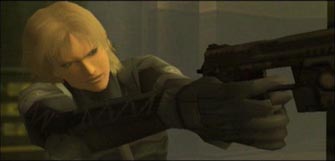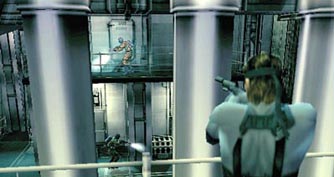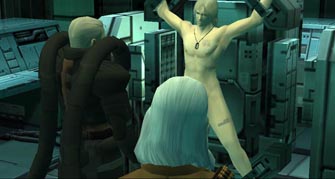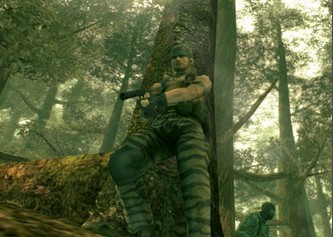 The secrets of Metal Gear have spread across the globe, with every nation now wielding the lethal technology. Solid Snake and Otacon have begun working for an anti-Metal Gear organization called Philanthropy, and the game opens with the duo infiltrating a container ship leaving New York harbor to investigate mysterious rumors of an amphibious prototype Metal Gear designed to best the existing generation of machines. FOXHOUND is still running, with a different cast but similar agenda; some time after Snake infiltrates the ship, untried FOXHOUND operative Raiden is sent to stop a group of terrorists who have taken over an offshore chemical cleanup facility and a bevy of hostages, including the President, in the process.
The secrets of Metal Gear have spread across the globe, with every nation now wielding the lethal technology. Solid Snake and Otacon have begun working for an anti-Metal Gear organization called Philanthropy, and the game opens with the duo infiltrating a container ship leaving New York harbor to investigate mysterious rumors of an amphibious prototype Metal Gear designed to best the existing generation of machines. FOXHOUND is still running, with a different cast but similar agenda; some time after Snake infiltrates the ship, untried FOXHOUND operative Raiden is sent to stop a group of terrorists who have taken over an offshore chemical cleanup facility and a bevy of hostages, including the President, in the process.
Metal Gear Solid 2: Sons Of Liberty is the 2001 sequel to 1998’s Metal Gear Solid. With the worldwide success of the previous game on the PlayStation, fans were desperate to see what creator Hideo Kojima could do with the then new PlayStation 2.
System: PlayStation 2, Xbox, PC (Windows)
Genre: Stealth, Action
First Released: November 13, 2001 (US), November 29, 2001 (JPN), March 8, 2002 (EU)
Players: 1
Developer: Konami
Publisher: Konami
Country of Origin: Japan
Say what you like about the Metal Gear games’ mix of cinema and play, but when a team that excels at graphical detail, atmospheric music and a penchant for extravagant and flamboyant stunts assembles a game, it makes for a phenomenal intro movie:
A Drama In Two Parts
For most of Metal Gear Solid 2 the principal character is not Solid Snake. It is the new, Virtual Reality trained FOXHOUND agent, Raiden. Raiden’s existence was kept secret prior to the game’s release, and reactions from fans who were hoping for another Solid Snake tale were mixed. On one hand, Hideo Kojima and his team had pulled an enormous bait-and-switch operation, on the other; they had produced a visually stunning game with an epic, at times mind-blowing story.
Solid Snake began his work on the PlayStation coming out of retirement. He’s always seen as immensely athletic, and his face is whiskered and hard. His husky voice is wisecracking and cynical, and, as you might expect, he has lost the ability to be surprised at the depths to which his fellow man will stoop to further their own ends. The player, however – and Hideo Kojima is always wary of the player’s interaction with the game – is navigating the world of subversive operations and high technology espionage with eyes wide open, learning as they go. There’s always going to be a limit to how naive Solid Snake can be – he’s an old hand; a man whose career has taken more turns than a Nascar racer.

Who’s A Pretty Boy, Then?
There are so many reasons for the decision to introduce a new principal character to the Metal Gear saga, but it’s also easy to understand the upset Raiden’s appearance caused. Seeing Solid Snake through to the bitter end of Metal Gear Solid makes it tough to relinquish control of the guy, but the switch adds depth to the canon.
With graphics and gameplay drastically improved but spiritually similar to that of the previous game, the plot and the drama that unfolds with the game is a major part of what makes Metal Gear Solid 2 what it is: an ambitious, complicated marvel.
Messing About In Boats
The only survivor from the Shadow Moses incident of the previous game is Revolver Ocelot, ricochet genius. A glimpse of him in the opening credits suggests intrigue to come, especially as he seems to have two hands, a substantial improvement on his last appearance.
In the first section of the game Solid Snake is on the trail of a new Metal Gear, with Otacon’s remote support. I found dialogue between the two characters at this stage of the game one of the high points of the game’s plot. Their exchanges refer to the first game, laden with self-referential humor and sarcasm. The writing has maturity and a wry tilt, and you gain a real sense of their relationship and opinion of each other, and because of that their discourse retains its reality even when Otacon is giving the player the usual infodump about new controls or unusual situations.
The tanker chapter asks many questions, not the least of which is “What’s going on?”
Ocelot and his cronies are intent on stealing the prototype Metal Gear from its owners, but these are internationally renowned villains we’re talking about, and at least some double-crossing was inevitable. As the twists and turns in the story begin to stack up, the writing strains a little under the pressure, but unlike the previous game, the ensemble of graphics, play and dialog actually comes off. More of the storytelling load is taken by flow between cutscene and play, rather than play and static dialog screens, and, for this stage of the game at least, the balance feels about right.
It’s revealed that Solid Snake’s clone ‘brother’ Liquid Snake, the leader of the rogue FOXHOUND crew in MGS1 is still alive -in a fashion- because Revolver Ocelot took Liquid’s arm to replace the one he lost. Liquid Snake can take over, almost possess, Ocelot, at will. Under the influence of Liquid, Ocelot steals the prototype Metal Gear and exits stage left, pursued by Snake.

Don’t Make It Angry
Offshore Accounts
Even as his chapter begins, Raiden’s identity is blurred, initially being called ‘Snake’ over the radio. It’s almost as though the production team wanted to lull players into the firm belief that this was also Solid Snake. Raiden infiltrates the ‘Big Shell’ offshore cleanup facility underwater, with the intent of freeing hostages, including the President of the United States, from members of a group called ‘Dead Cell’, also calling themselves the ‘Sons of Liberty’. As he makes his way through the facility there is a much stronger vein of similarity to the previous MGS – Colonel Campbell is guiding the mission, and while there is also female audio support, it is rather unusually provided by Raiden’s girlfriend Rose. As is made transparently clear as the game progresses, she’s quite a worrier, and apparently even wore down FOXHOUND’s commanders in her quest to keep an eye on her boyfriend.
The Sons Of Liberty and ‘Dead Cell’ consist of the roller-skating, bomb-loving Fatman, superfast, blood-loving Vamp, who also has the ability to survive horrific wounds, and Fortune, who deflects any projectile launched at her. Atop the pile is another clone of Big Boss – the former president of the United States, Solidus Snake. Standing beside him is Revolver/Liquid Ocelot, last seen in possession of prototype Metal Gear RAY, and in the two years since the tanker chapter, that one RAY has become many, many more…
As the player’s view of events begins to buck underneath cleverly induced preconceptions, the similarities between MGS1 and MGS2 stack up, strange characters appear, both familiar and yet different. The fourth wall is crossed and re-crossed and the player’s mind is toyed with, played with, almost, by the story as it takes loop-the-loops of logic in the space between the real world and the game world. And always, behind the scenes, referred to in shadowy terms and almost in awe as master manipulators and puppeteers of all, are an organization called The Patriots.
Fight and Flight
Metal Gear Solid 2 is spiritually true to the previous game. The controls are more complex, but retain the same feel – this is the same Solid Snake, with the same pace and movements, only the graphical superiority of the PlayStation2 means the focus is a little better. The first person shooting controls open the door to inventive interaction with the environment – shooting pipes to blind guards with steam, or spraying papers or fruit across their line of fire, and the camera switch is quick and intuitive to use. The tranquilizer pistol is a stroke of genius in terms of gameplay. With a silenced pistol a few random shots should dispatch an enemy, but tranquilizers take a while to take effect depending on where on the body the dart hits. A headshot leads to instant sleep, but a dart in the leg or arm gives a guard enough time to raise an alarm or fire back. This gives the player a huge impetus to fire carefully, subtly but strongly enforcing the benefits of a stealthy approach.

Shooting Gallery
Weapons come thick and fast; there’s excellent variety with a few favorites from the last game thrown in, but the balance of power between the player and the massed enemy guards has shifted – an alarm will now bring a squad of reinforcements to an area, who thoroughly scope the place, checking shadows and corners, covering exits and occasionally even looking in lockers and cupboards for hiding suspects. Continued resistance will bring more guards with riot shields and more powerful weaponry. Patrolling guards who discover a wet footprint on the deck or an unconscious comrade will raise the alarm – so Raiden and Snake have to be careful about the sorts of trails they leave. Snake and Raiden can hang from ledges to sneak past guards for a limited time, depending on their strength – which can be improved by doing pull-ups – and the peeking mechanism from the previous game which allowed a discreet look around a corner has been expanded to allow shooting from cover.

Line ‘Em Up, Knock ‘Em Down
The camera movement is a lot more fluid and focused than the previous game. It will follow Snake and Raiden within the environment where it can, and the presentation of the ‘lid-off-the-building’ level sections is much less jarring to the eye. Environmental damage, while far from pixel-perfect, is excellent for the PS2, and the damage-detail at times is amazing, although specific to certain instances (one bar full of individually shootable bottles, a huge glass window) rather than uniform throughout the game. One thing that is especially impressive is the character design and clothing graphics. While the environmental detail is high, the layers of texture and form that have gone into the character design is truly remarkable.

Discretion Is The Better Part Of Valor
Experience
For all their high-tech gadgets and plot, if MGS2 and MGS1 were works of literature, you could happily call them magical realism. From the fantasy-world style codenames to the mystical aura surrounding the main characters and their enemies, and no matter how strongly enforced by technological or scientific explanation, the story of conspiracy, betrayal, identity and ideas is grounded in real people with motivations and complexities who are nonetheless faced with a series of events so incredible they border on unbelievable. Once the player takes the first step by accepting the plot, it’s one hell of a ride.
Check out this gameplay video, from the tanker chapter, so as not to give away too much of the plot:
Fun Factor: 9/10
Metal Gear Solid 2 works. The balance between cutscene and gameplay was always going to be difficult when the developers strove to do so much with both, but I’m very happy to say it comes off much better than the previous game, even when, towards the end, the cutscenes heavily outweigh the playable sections. The gadgets and weapons are fun to use and incredibly satisfying to use well. The characters, even when exposing their sordid sides, are simply very very cool. The dialog might be a little wooden at times, but when it occurs over the top of gorgeous and explosive action scenes, it doesn’t matter as much as it does when the dialog takes place over a static screen.
Graphics: 9/10
The polygon count has gone up, the precision of the detail has gone up, but because of the mind-blowing integrity and scope of Metal Gear Solid, this sequel feels very much like the same world. The lighting and color palette retains the same blue-green tint, the weather is marvelous, the attention to level detail is superb and the animation, while a little jerky between preordained sequences, is wonderfully rendered.
Audio: 9.5/10
The music in this game is excellent. It swells and ebbs under the action, the theme is stirring and catchy and the atmospheric sound and noise spot on. My only gripe is the voice acting, and I think even then the actors are making the best of a script that can only generously described as stilted in places.
Ingenuity: 8/10
The way the game has built upon its previous structures and gameplay methods is very clever. There is a stylistic continuity as well as development and growth. There is something new to learn about and deal with at every level, constantly revising the player’s expectations and concerns. After your first laser trap, you must be wary for more, after your first guard resists tranquilizers long enough to raise an alarm, you’ll think twice about firing haphazardly. This honing of technique and method of play constantly keeps you on your toes. Stealth is optional, but strongly enforced – guards once alarmed will not stick to standard patrol patterns. This is a real breath of fresh air when it comes to stealth gaming play, and most games where a lone attacker comes up against a network of guards – without regular patrol patterns to rely on and regular timings aiding sneaking past, life becomes a lot more difficult for Snake and Raiden.
Replay Value: 8/10
Beyond the simple fact that the story is deep enough to warrant a second visit, Metal Gear Solid 2: Sons of Liberty, and the bonus re-release, MGS2: Substance are packed with features to keep gamers coming back. Guards and bosses yield collectible dog tags to unlock different player outfits. Substance includes over 300 missions in the style of MGS1‘s VR Training Missions, as well as… and I am grinning as I type… a really enjoyable skateboarding mode.
Next in the Metal Gear Solid series of reviews we’ll be looking at Metal Gear Solid 3: Snake Eater, and the ultimate soldier and clone-father of Solid Snake, Big Boss.

